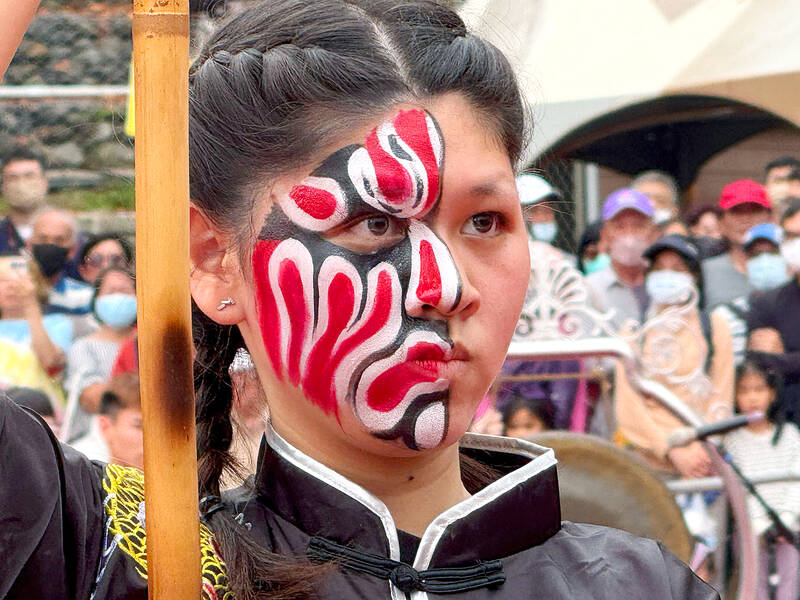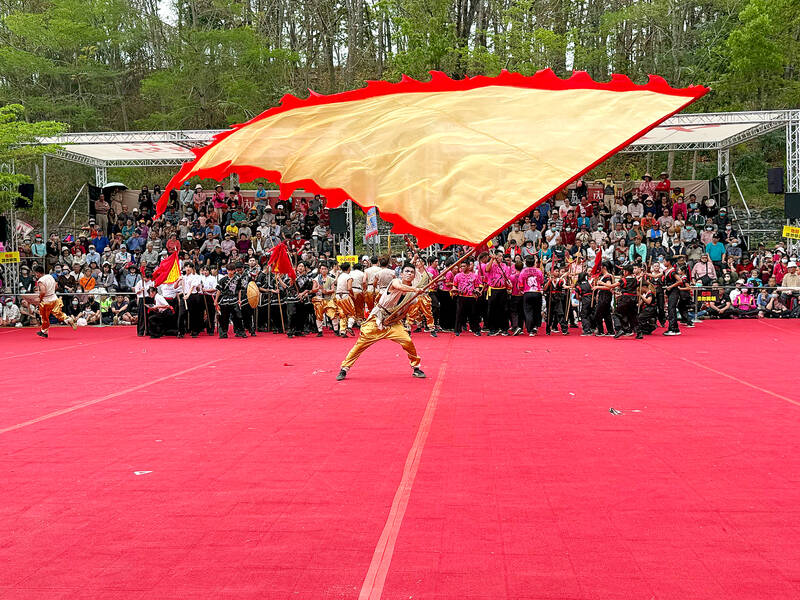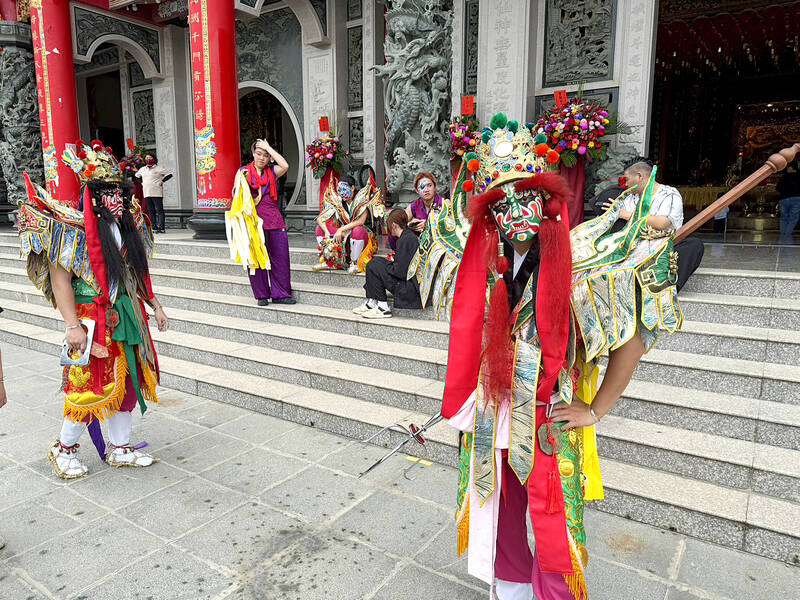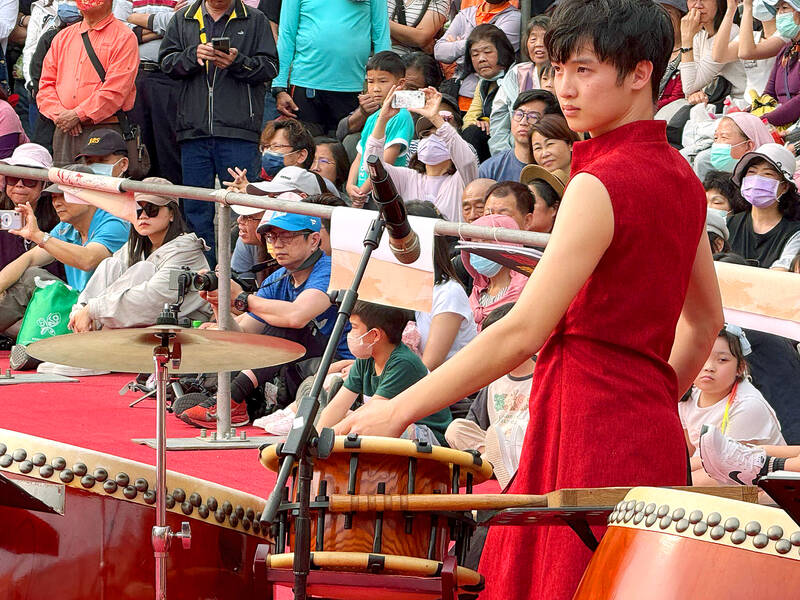Shunxian Temple (順賢宮) is luxurious. Massive, exquisitely ornamented, in pristine condition and yet varnished by the passing of time. General manager Huang Wen-jeng (黃文正) points to a ceiling in a little anteroom: a splendid painting of a tiger stares at us from above. Wherever you walk, his eyes seem riveted on you.
“When you pray or when you tribute money, he is still there, looking at you,” he says.
But the tiger isn’t threatening — indeed, it’s there to protect locals. Not that they may need it because Neimen District (內門) in Kaohsiung has a martial tradition dating back centuries.

Photo: Julien Oeuillet
On April 5, Shunxian Temple hosted the Neimen Songjiang Battle Ritual, a yearly competition that combines choreographed martial arts and traditional theater.
MARTIAL TRADITION
The Songjiang Battle Ritual is a deeply Taiwanese tradition and stems from the region’s history of irredentism and local resistance to outside rule.

Photo: Julien Oeuillet
Militias were first formed by speakers of Hokkien (commonly known as Taiwanese) villagers of the Neimen area to defend themselves against raids by the indigenous population and Han Chinese pouring in from Tainan, then the seat of the Qing Empire’s attempts at subjugating the island.
Later on, the Neimen warriors allied with one of the indigenous communities to push back on Qing forces. The ritual was thus born at the moment when the island grew an identity away from the common root of the ancient Sinosphere.
Despite its ages-old character, the Songjiang Battle Ritual is a celebration of juvenile passion, dedication and determination.

Photo: Julien Oeuillet
Each troop numbers around two dozen, mostly in their early twenties, telling a story through simulated fighting, with weapons or bare limbs.
Live and recorded music is constantly booming, while flag-bearers wave their colors, sometimes carrying gigantic banners. Not a word is uttered: their choreographed fights, screams, movements and props do the job.
HONORS

Photo: Julien Oeuillet
This year’s winning team, Fengwu Xinchuan-Xiluo Fengshan Pavilion (鳳武薪傳西螺鳳山館), used modern imagery to tell the story of folk hero Liao Tian-ding (廖添丁), a sort of Taiwanese Robin Hood celebrated for his resistance to Japanese rulers in the early 1900s.
For their efforts, the troupe, received honors from local officials, including Ho Kuo-jao (何國昭) a 101-year-old kung-fu master.
After the competition ends, the food stalls close up, and performers and the audience disperse. Inside the temple, a few late pilgrims come to pray to Matsu and the deity of martial artists, Guan Yu, all while the tiger continues to cast its protective gaze.

Photo: Julien Oeuillet

June 23 to June 29 After capturing the walled city of Hsinchu on June 22, 1895, the Japanese hoped to quickly push south and seize control of Taiwan’s entire west coast — but their advance was stalled for more than a month. Not only did local Hakka fighters continue to cause them headaches, resistance forces even attempted to retake the city three times. “We had planned to occupy Anping (Tainan) and Takao (Kaohsiung) as soon as possible, but ever since we took Hsinchu, nearby bandits proclaiming to be ‘righteous people’ (義民) have been destroying train tracks and electrical cables, and gathering in villages

Dr. Y. Tony Yang, Associate Dean of Health Policy and Population Science at George Washington University, argued last week in a piece for the Taipei Times about former president Ma Ying-jeou (馬英九) leading a student delegation to the People’s Republic of China (PRC) that, “The real question is not whether Ma’s visit helps or hurts Taiwan — it is why Taiwan lacks a sophisticated, multi-track approach to one of the most complex geopolitical relationships in the world” (“Ma’s Visit, DPP’s Blind Spot,” June 18, page 8). Yang contends that the Democratic Progressive Party (DPP) has a blind spot: “By treating any

This year will go down in the history books. Taiwan faces enormous turmoil and uncertainty in the coming months. Which political parties are in a good position to handle big changes? All of the main parties are beset with challenges. Taking stock, this column examined the Taiwan People’s Party (TPP) (“Huang Kuo-chang’s choking the life out of the TPP,” May 28, page 12), the Democratic Progressive Party (DPP) (“Challenges amid choppy waters for the DPP,” June 14, page 12) and the Chinese Nationalist Party (KMT) (“KMT struggles to seize opportunities as ‘interesting times’ loom,” June 20, page 11). Times like these can

Swooping low over the banks of a Nile River tributary, an aid flight run by retired American military officers released a stream of food-stuffed sacks over a town emptied by fighting in South Sudan, a country wracked by conflict. Last week’s air drop was the latest in a controversial development — private contracting firms led by former US intelligence officers and military veterans delivering aid to some of the world’s deadliest conflict zones, in operations organized with governments that are combatants in the conflicts. The moves are roiling the global aid community, which warns of a more militarized, politicized and profit-seeking trend